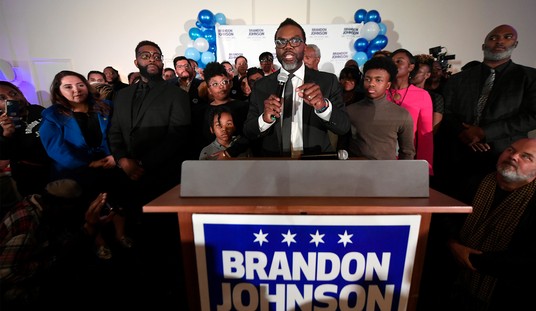My headline sounds poll truther-y but that’s not how it’s intended. National polls — of likely voters, at least — are interesting as a bird’s-eye view of the national popular vote. A few of them, especially ABC/WaPo, were darned accurate in predicting the final popular margin between Clinton and Trump in 2016.
But yesterday’s NYT poll of battleground states was such a bombshell in confounding the conventional wisdom about how much electoral trouble Trump is in that I don’t know how anyone can look at a national poll the same way afterwards. If you missed it 24 hours ago, read it now. It’s the most significant political survey to drop all year. Trump routinely gets blitzed in head-to-head match-ups against Democrats in *national* polls and today’s new data from ABC/WaPo is particularly lurid, showing him getting trounced by everyone from Biden to Warren to even Kamala Harris. She leads Trump by nine — the slimmest lead of five candidates tested. To put that in perspective, Obama’s landslide win over John McCain in 2008 saw a final margin of just seven points. Even accounting for the fact that ABC/WaPo sampled registered voters rather than likely voters, among whom the race is apt to be tighter, the prospect of Democratic victory next year seems highly probable no matter who they nominate.
On Earth 2, I mean. On Earth 2, the electoral college has been abandoned and the presidency is decided simply by popular vote. On Earth 1, however, it’s the NYT’s data (which polled likely voters, not registered voters) that’s much more important: Trump may well lose more decisively in the popular vote next year than he did in 2016 thanks to mega-landslides in big blue states like California and New York but his strength *in the battlegrounds* suggests we’d have a photo finish in the electoral college even if he faced a comparatively electable Democrat like Biden. If he faced Warren, there’s every reason right now to believe he would win.
So, take this new ABC/WaPo data for what it’s worth: Not quite nothing, but pretty close.
Former vice president Joe Biden, Sen. Bernie Sanders (I-Vt.) and Sen. Elizabeth Warren (D-Mass.) run strongest against the president nationally, with Biden leading by 17 points (56 percent to 39 percent), Warren by 15 points (55 percent to 40 percent) and Sanders by 14 points (55 percent to 41 percent).
South Bend, Ind., Mayor Pete Buttigieg and Sen. Kamala D. Harris (D-Calif.), the other two Democrats tested against Trump, also lead the president among registered voters, with Buttigieg up by 52 percent to 41 percent, and Harris ahead by 51 percent to 42 percent…
[T]he national results represent a shift away from Trump since the summer, when only Biden had a clear advantage over the incumbent. With Republicans and Democrats mostly locked in on their voting intentions, the biggest difference between the results from July and those in the new poll is that independents have moved in the direction of the Democratic candidates.
Assume that every Democratic lead here is half as large among likely voters as it is among registereds and you still have some garish advantages for the likes of Biden and Bernie over Trump.
How do we reconcile that giant gap with the fact that the battleground races in the NYT poll were so tight? After all, swing states do correlate to some degree with the national electorate. If we end up in a recession next year, that’ll be held against Trump in all 50 states, albeit more strongly in some states than in others. A narrow disadvantage in the national popular vote a la 2016 would leave him with a strong chance of narrow victories again in the Rust Belt and Florida, enough for 270 electoral votes. A huge disadvantage in the national popular vote will leave him a sitting duck. So although the ABC/WaPo and NYT numbers don’t directly contradict each other, they do indirectly contradict each other. Whom should we trust?
Nate Cohn of the NYT makes the case for trusting his data:
The ABC/Post poll otoh is fairly small for a national poll (~850 RVs). Doesn't make it wrong. But the difference could be sampling error on their end; if they did it again, it could be much better for Trump. It's worse for him than others, including their own prior polls
— Nate Cohn (@Nate_Cohn) November 5, 2019
I think that gap is fairly manageable. A 3 pt difference is pretty well within the range where we expect polls to differ. I wouldn't insist either side is right or wrong, etc.
— Nate Cohn (@Nate_Cohn) November 5, 2019
We also make sure we have a representative number of low turnout voters, who are really hard to reach and basically can't be properly sampled by most other pollsters.
All of this is expensive, but it gives us a far better shot to capture the people who get missed by surveys— Nate Cohn (@Nate_Cohn) November 5, 2019
Now, we do our polls the way we do them for a reason. It lets us get the partisan balance right, which is a big source of noise (and possibly bias) in other polls. It lets us reach low turnout voters, since we know who has or hasn't voted before we call them.
— Nate Cohn (@Nate_Cohn) November 5, 2019
What use remains for national polls if you’re sold that battleground polling is the place to be? Well, they might be useful in detecting trends among the broader electorate that will eventually trickle down into swing states. Note the bit at the end of the excerpt above about independents shifting towards the Democrats, for instance. Note too that Biden, Warren, and Sanders each lead Trump nationally by wider margins today than they did when ABC/WaPo last polled the race in September. Warren in particular has improved dramatically, doubling her lead over Trump from seven points to 15. In other words, although the NYT momentarily sees Trump beating Warren in the battlegrounds, his lead is small and it may be shrinking as we speak. National polling will give us an inkling about the drift in swing states going forward.








Join the conversation as a VIP Member